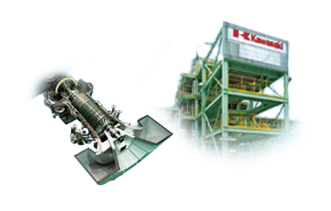Creating Clean Energy
Kawasaki seeks to create clean energy by establishing a CO2-free hydrogen energy supply chain designed to reduce environmental risk on a global scale.

Corporate Technology Division
Creating Clean Energy
As it aims to contribute to the development of a hydrogen-powered society, Kawasaki is pursuing its goal of becoming a supplier of comprehensive system packages associated with liquefied hydrogen infrastructure by 2030 via the provision of hydrogen liquefaction and loading and unloading facilities, liquefied hydrogen carriers and hydrogen-fueled gas turbines. To achieve this goal, we are working with partner companies to develop key hydrogen supply chain technologies. These technologies include those associated the production of hydrogen from renewable energy and from Victorian coal in Australia, with the aim of making profitable use of this underutilized resource, as well as hydrogen liquefaction technologies. With regard to the transportation of hydrogen, our large-capacity carrier ships are expected to play an essential role along with our loading and unloading facilities. Furthermore, we will support the storage of liquefied hydrogen as well as hydrogen utilization via power generation employing gas turbines optimized for this fuel. Applying CO2 capture and storage (CCS) technologies at the production stage when obtaining hydrogen from fossil fuels enables the use of hydrogen as a source of clean energy by controlling CO2 emissions all the way from production to utilization. Once established, the hydrogen supply chain that Kawasaki is building will be able to stably supply large quantities of clean energy while considerably reducing CO2 emissions. We have steadily advanced the construction of facilities for the demonstration of this supply chain and begun research and development aimed at scaling up these facilities for commercial use. We are making steady progress, including the commencement of demonstration testing, toward greater efficiency and convenience in heat and electricity supply via pure hydrogen combustion.

2030 Target/KPI
- CO2 reduction through use of hydrogen energy: 3 million tons
- Hydrogen transport volume: 225,000 tons per year
Goal for fiscal 2021
- Complete the demonstration of a hydrogen supply chain spanning Japan and Australia
Fiscal 2019 results
- Launched a small liquefied hydrogen carrier, built a liquefied hydrogen receiving terminal in Kobe, and built liquefaction and loading facilities in Australia, aiming to implement supply chain demonstration
- Began demonstration testing aimed at increasing the efficiency and convenience of heat and power supply from the mixed combustion of natural gas and the combustion of pure hydrogen in an urban area of Kobe
Contact
If you need more information about our business,
please feel free to contact us.






